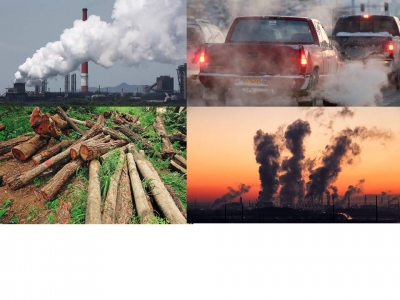
Earth’s climate has always changed naturally over time. However, climate change now appears to be speeding up! Many recent changes in climate are caused by our modern way of life. Earth is getting warm, which can have a huge effect on the environment.
Causes:
Humans are thought to be responsible for the most recent, major climate changes. Waste gases from industry, transport, and deforestation have built up in Earth’s atmosphere. These trap more heat around the Earth, so temperatures rise.
Industry:
Whenever we burn oil, coal, or natural gas, waste gases are released into the atmosphere. The most well-known and the most important greenhouse gas is CO2. The concentration of CO2 in the atmosphere is subject to variation even without human intervention. The carbon cycle causes an exchange of CO2 between the biosphere and the oceans on the one hand and the atmosphere on the other.
Vast amounts of CO2 are also released by the burning of fossil fuels. There is incontrovertible evidence that the CO2 concentration in the air has never been so high in 800,000 years (probably even 60 million years) as it is now. The trend suggests that CO2 emissions will continue to rise globally, although the economic crisis did prevent a rise in 2009. The Netherlands (per head of population) is high on the list of CO2 emitters in the world.
Besides CO2, methane (CH4), nitrous oxide (N2O), fluorinated gases, ozone (O3) and water vapor are important greenhouse gases. Water vapor plays a unique role as it strengthens the heat-trapping effect caused by other greenhouse gas emissions. This is because a warmer atmosphere retains more water. The amount of water vapor cannot be artificially increased or decreased.
Transport:
We now use cars, buses, and planes regularly. They all fill the air with lots of waste gases. Transportation is the single largest contributor to the nation’s carbon footprint, causing more damage than industry, homes or commercial buildings. More than four-fifths of transportation emissions come from the tailpipes of our cars, trucks and buses.
Three factors affect the amount of carbon released into the air from transportation: the type of fuel we use, the fuel efficiency of the automobiles we drive and the amount of driving we do. Some improvements are being made on the first two legs of this stool with the push for hybrid/electric vehicles and tighter fuel economy standards.
Progress is much slower on the third leg: curbing the demand to drive. Though driving is down now because of our economic malaise, studies show that even small increases will spew out so much carbon that they will wipe out the benefits of fuel-efficient cars and the expansion of clean-fuel alternatives.
Deforestation:
Trees help remove gases from the air. As more trees are cut down, more waste gases stay in the air. Water vapor is another greenhouse gas that keeps heat from the sun trapped in the Earth’s atmosphere and helps maintain a temperature at which life can flourish on our planet. However, deforestation also affects the amount of this in the air. Studies have shown that deforestation has contributed to the amount of water vapor in the air and, over just a few years, the amount of water vapor present has increased by four percent. Besides increasing the temperature of the Earth’s surface and atmosphere, this also has knock-on effects for weather patterns.
Picture Credit : Google




